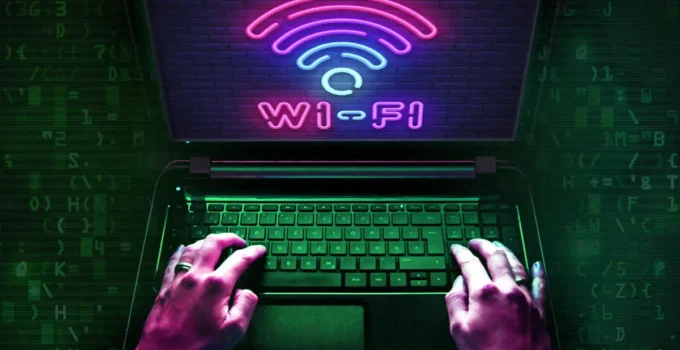If you’re asking “Can hackers break WPA2 encryption?” then the short answer is: theoretically, yes. But don’t worry – the longer answer is a bit more complicated and involves understanding the strengths and weaknesses of this popular internet security protocol.
Let’s take a look at what you need to know about WPA2 encryption and how to secure your network against potential hackers.
What are the Weaknesses of WPA2 Encryption?

Source: sectigostore.com
It is an encryption technology used for Wi-Fi networks. WPA2 encryption creates an encrypted tunnel between the access point and all connected devices in order to protect your data from interception. But like any technology, WPA2 has its weaknesses that hackers can exploit to gain access to a Wi-Fi network.
Weaknesses in it have been known for some time, but recently several serious vulnerabilities have been discovered that make it easy for hackers to gain access to your Wi-Fi network without having to crack the encryption. These weaknesses include:
- KRACK Attack: This type of attack involves exploiting the WPA2 handshaking process, allowing attackers to decrypt data sent over wireless networks by manipulating and replaying transmitted cryptographic messages.
- WiFiphishing Attack: In this type of attack, hackers set up a “fake” wireless network using a system they control as an access point rather than a normal router or access point. This can allow them to covertly intercept data being sent over the real Wi-Fi network while tricking users into connecting and sending their data through the fake system instead of the real one.
- Rogue Access Point Attack: In this attack, hackers place a rogue wireless access point on the same local area network as legitimate ones in order to intercept wireless traffic without having cracked or manipulated any authentication passwords or keys.
These types of attacks are relatively easy for attackers to pull off if they have physical access to your network or are extremely close by, such as within range of public hotspots in public places like parks, restaurants and coffee shops. Protecting yourself from these attacks means doing what you can to limit their impact by understanding how they work and taking steps like setting up secure profiles on each device connected to your Wi-Fi router for added protection against outside intrusion in addition to changing passwords regularly and running updates when available.
Can Hackers Break WPA2 Encryption?

Source: networkworld.com
Wireless Fidelity (Wi-Fi) security has been a hot topic in recent years, and researchers have found several vulnerabilities in the Wi-Fi Protected Access II (WPA2) encryption protocol. This encryption is used on nearly all Wi-Fi networks, meaning that if hackers were to breach it, they could gain access to thousands of unprotected devices.
At its core, it is an algorithm that was designed to prevent unauthorized access to a Wi-Fi network by encrypting data sent over the air between your device and the router you’re connected to. It uses a combination of three different types of protection: authentication, encryption and digital signature verification. In order for two devices to be able to communicate with each other, their signals must be authenticated with each other first before data can be exchanged between them. The encryption process is then used to scramble any unauthenticated data transmissions so that even if an intruder were able to gain access, he would not be able to determine what data was being exchanged between the two devices. Finally, digital signature verification allows for further validation of any transmitted packets as well as tracking who sent them in case intrusions occur later on down the line.
Although it has largely been proven secure against some of the most common types of cyberattacks such as brute force attacks or air sniffing attacks, there are still some risks associated with its implementation. One major vulnerability comes from an attack known as a Key Reinstallation Attack (KRACK). This attack exploits an implementation flaw within WPA2’s four-way handshake process which results in replay attacks being successful and thus allows for intruders or malicious actors one step closer into gaining access into your connected devices.
Despite these potential vulnerabilities associated with this protocol implementation and usage, it remains one of the most secure Wi-Fi security protocols available on the market today and will continue being used for years to come. While there may exist other alternatives such as Wired Equivalent Privacy (WEP) or more recently introduced Wi-Fi Protected Access III (WPA3), these protocols generally will not provide users with benefits compared with using current WPA2 implementations nor compatibility across routers supporting older standards making them largely impractical implementations versus using WPA2’s methodology while its current security backstops remain intact.
How Can You Protect Yourself From WPA2 Encryption Hacks?

Source: freepik.com
The best way to protect yourself from security threats is by understanding how your networks, devices, and information are vulnerable and taking proactive steps to protect them. Even if your data is encrypted using WPA2 encryption, hackers can use a variety of techniques to attack your system and access private files.
The most important step is to keep all of your software up-to-date with the latest security patches. Outdated or unsupported software may have known vulnerabilities that hackers can exploit. Additionally, you should use secure passwords, install a firewall on all public networks, and ensure that devices connected to the network are configured securely.
You should also be sure to keep network configurations simple. Keeping an up-to-date record of connected users and their authentication details can help ensure that insider threats do not go unnoticed. It’s also a good idea to limit access as much as possible so only authorized personnel can access specific credentials or other sensitive information. Finally, you should employ antivirus software or personal firewalls on all laptop or mobile devices that connect to your network in order to detect any suspicious activity on the device itself before it reaches the network.
Conclusion
In conclusion, the WPA2 protocol does a good job of protecting wireless networks. While it is possible for hackers to break the encryption and eavesdrop on a network, the task is complicated and time consuming enough that it is unlikely to be attempted against most home network users.
It is important to have an understanding of security measures used by your router, including both administrative and operational. Additionally, strive to use strong encryption keys with your wireless signal that are difficult to guess or uncover.
By following these steps, you can greatly reduce the chance that anyone would be able to gain access to your protected WPA2 encrypted connection.


